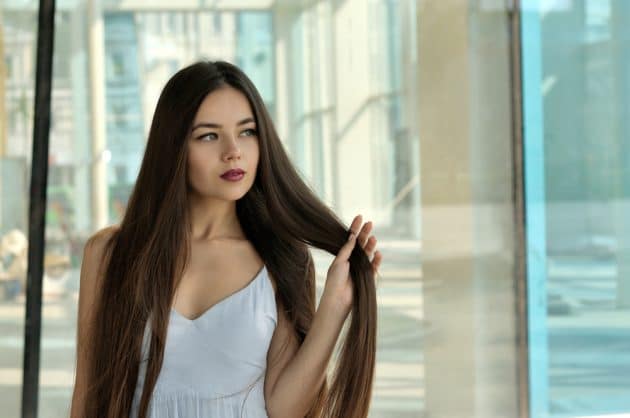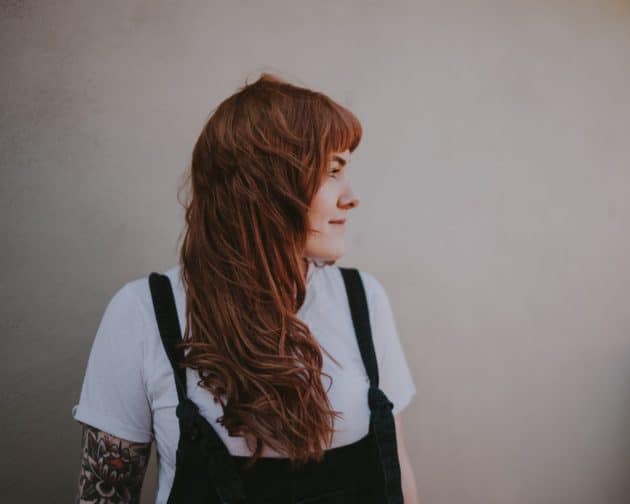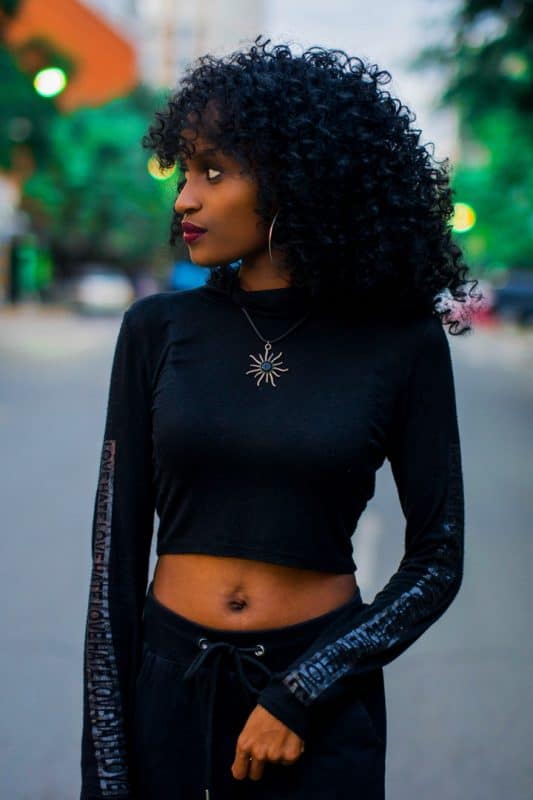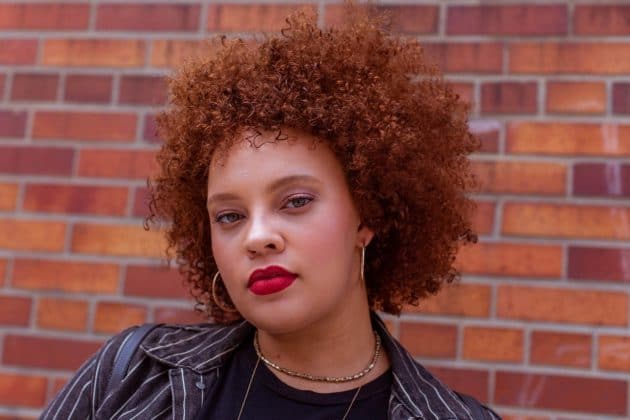Each hair has its own specificity, i.e. special characteristics that make them different from each other. These particularities require specific care, so only by knowing your own hair very well can you give it all the care it needs. That’s why to have beautiful, radiant and healthy hair, it is essential to understand about the hair types. But don’t worry, we’ll explain everything around here!
What determines hair types?
Hair follicles are structures, as if they were “pockets”, scattered all over our epidermis, that is, the most superficial layer of our skin. These follicles are responsible for giving origin to the thread, because they produce the main compound of our threads, a type of protein called alpha-keratin. In each of the thousands of alpha-keratin chains, inside each thread, there are sulfur atoms. When the binding of two of these atoms occurs, it is called the disulphide bond. Right now you are probably asking yourself, “Okay, but why is this important?” simply because it is this disulphide bond that will define the structure of the thread, that is, define whether it is a straight, wavy, curly, or curly hair. To explain better, the more disulphide bonds, the more curly this strand will be, the fewer bonds, the straighter.
Types of hair
For each hair type, there is a subcategory that helps us to understand the most specific characteristics of each hair. Below are the groups that define each type of straight, wavy, curly and curly hair.
Smooth
-Smooth hair 1A: this is the first group of straight hair. Without any kind of waving, its structure is fine and for this reason the natural oil present in the scalp goes down its whole length with ease. Consequently it is a very soft and shiny hair, because the natural oil has this power of treatment on the wire. However, it is also very oily and volume free hair for this exact reason.

-Smooth hair 1B: it’s that straight hair a little thicker, but it has less oiliness than hair 1A. In some cases, this oiliness is concentrated only in the region of the scalp, while the length and tips are normal to dry. Because they are not as oily as the previous one, they have a little more volume.

-Smooth hair 1CThe straight hair of the third group is the one with the thickest structure. For this reason, it is quite dense and heavy. It suffers even less from oiliness and is more bulky than the other two. It is a very resistant and shiny hair. This type of hair is very common in women of Eastern descent.

Wavy
-Wavy hair 2AIt is only considered a wavy hair because it is very lightly wavy, however, it is practically straight. Its structure is fine and, consequently, it is not bulky. Among the other groups of wavy hair this is the most oily, especially at the root.

-Wavy hair 2BThat’s that “S” shaped wave. That’s probably the main reference for wavy hair when we think of this name. It is also the best representation of the texture called “beach waves” or in Portuguese, beach waves. Because it has that stripped trim with little or no definition, very beach style indeed. This thread has medium thickness and tendency to frizz, besides being less oily than the previous one.

-Wavy hair 2CAlso called curly, 2C hair is already very close to curly, because it has a more defined shape, like a curly well open. Because it is thicker than the others, it is usually slightly oily at the root while the ends are more dry. It is also bulkier than 2A and 2B threads.

Curly
-Curly hair 3A: although this is the first strand of all types of curly hair, it is still very much like 2A hair. For this reason it still has that curly finish, because it is a very open curl. What differentiates it from the previous group’s hair is its definition, which is a bit bigger.

-Curly hair 3BThis is already a complete curly hair, it has the most closed structure than the previous one, like a medium curly. It has enough definition and a super volume. In this curvature the drying of the hair starts to become more severe.

-Curly hair 3CThey are much tighter and dryer curls, which is why it is very confusing with 4A curly hair. It has an incredible definition and already suffers with the shrinkage factor. Don’t you know what that is? It’s the curly hair that ends up showing reduced volume of reality, due to the curvature of the curls, that is, its spiral shape.

Crespo
-Coarse hair 4AThe similarity with 3C hair is very large, however, its curls are even tighter and therefore even more voluminous. This hair is also more dry than those of the curly group, so it does not have the same shine as 3C, being more opaque.

-Coarse hair 4BIt is here that the curly threads begin to lose their definition in a spiral shape and present a zigzag shape, that is, as a “Z”. This hair is extremely bulky, on the other hand, the dryness is severe and the opacity greater, making it a very fragile hair. The shrinkage factor is also quite intense.

-Coarse hair 4CIt has little or no definition, not even in “Z” format and has an enviable volume. Of all hair types, this is, in fact, the most voluminous, with greater intensity of shrinkage factor and greater natural dryness, making it the most delicate and fragile of curvatures, requiring special care to maintain its health and beauty.

Care according to each hair type
Once you understand a little more about each type of wire, it becomes easier to find out what care each one needs. This is because, knowing the characteristics and weak points of these hairs, we can create a program of specific treatments to solve the individual problems of each hair texture. Check below how to take care of your hair properly.
Straight hair care
As mentioned earlier, straight hair is more oily than wavy, curly and frizzy hair. For this reason, two things are very important for this type of hair: washing frequency, correct shampoo and hydration.
Very oily hair can develop other types of scalp disorders such as dandruff, among other problems. Besides, nobody likes to look that super oily, isn’t it!? Therefore, it is very important to take the washing frequency very seriously.
To begin with, if your hair is very oily, there is no point in washing it constantly. This is because washing your hair in excess is not ideal for hair either, as it can cause the reverse effect. “But how does that happen?” Well, washing your hair too much ends up drying your scalp, that is, removing all its natural oiliness, this way, it makes the sebaceous glands produce even more oiliness, making the situation worse. Therefore, the ideal is always to wash your hair one day yes and another day no.
It is cool to be aware of the shampoo being used. Opt for products developed for oily hair that cleanse the scalp more deeply, but without drying out. This way, the cleaning of the hair can last longer, avoiding that you have to wash every day. In case this option is not working, seek a dermatologist so that he can make a more detailed analysis of the situation.
Anyway, it is very important that your hair is always clean too, so avoid going many days without washing your hair, especially if you have more oily hair, because, as we said before, the excess oiliness and dirt on the scalp bring only problems.
Hydration for straight hair
Another very important point is hydration. Many people who have greasy hair believe that their hair does not need hydration, which is a mistake. Every hair needs hydration, okay!? The only caveat is that the frequency should be reduced, try to do it every 15 days and if your hair is very oily at least once a month. Also opt for lighter moisturizing masks developed for straight hair, like those of the My Straight line of Salon Line.
Hydration for straightened hair
Last but not least, are the hair straight and with chemistry, such as straightening, dyeing or discoloration. These usually have dry or brittle ends as a result of chemical processes. For this, the ideal is to make regular treatments following a hair schedule, we will talk more about it soon. In the case of very damaged hair, give preference to the reconstruction stages.
Just remember that to wear treatment masks on any type of straight hair you should always apply only to the length and ends, root never. If your hair is too greasy apply only to the ends.
At the end a very light leave-in and tip repairer after dry is enough. If you use a dryer and plate remember to apply a product with thermal protection before.

Wavy hair care
The wavy threads are usually oily at the root and dry at the tips. Therefore, the best treatment for this type of hair is also hydration. This is because it is not as oily as straight hair, but needs more washing because of the heavier root. With the most frequent number of washes, natural moisture is lost more easily, so you need to hydrate your hair more often. The ideal is to moisturise wavy hair at least once a week with a moisturising mask developed for wavy hair, such as the My Straight Wavy mask from Salon Line. However, it is also important to follow a complete hair schedule.
Finally, opt for a more fluid combing cream or a sprayer, which have a lighter consistency. A good option is the texturizing spray of this same line.

Curly and frizzy hair care
Although they have different structures, the care with these two types of wires is very similar. This is because both have a curvature that makes it difficult for the natural oil of the scalp to pass through the entire length of the thread. In this way, curly and frizzy hair presents dryness in the length and, especially, ends of the hairs. Due to this dryness, these hairs are more fragile and susceptible to damage, and can be more brittle and opaque.
Hair schedule for curly and frizzy hair
To treat these strands, the best solution is to focus on the nutrition stages of the hair schedule. Remembering that the other steps of it are also essential for curly and frizzy hairs. However, what these types of hairs need most is oil replacement, as we’ve seen before, and nothing better than capillary nutrition for this. When performing this treatment you should invest in a good mask of nutrition enriched with vegetable oils or buy an oil of 100% vegetable humectation, such as Coconut Oil Pure #todecacho.
If you’ve never used an oil of humectation, don’t worry, it’s very easy. You can add some of this oil to your favorite moisturizing mask and apply it to clean, damp strands or bet on hair humectancy. To do a humectancy, apply the oil to all the hair before washing. Wait at least 40 minutes. After that rinse well and wash with shampoo and conditioner. You can also leave the oil acting during the night, technique called night humectation. For curly and frizzy hair the indication is to do nourishment on an average of twice a week.
Finishing for curly and frizzy hair
At the time of finishing curly and frizzy hair, the care differs a little. For curly hair the ideal is combing creams or curl activators that work to define its structure. For curly hair it is more interesting to bet on products that enhance its natural volume.

Schedule for each hair type
The capillary schedule is a care agenda with three stages, which are: hydration, nutrition and reconstruction. The hydration that returns the moisture to the threads, the nutrition of the oils and reconstruction of the keratin or hair mass.
All the steps of the hair schedule are essential for any hair type, so everyone should follow a hair schedule. However, each group should give more emphasis to one of the steps.
Smooth and wavy: should give preference to the hydration stages.
Curly and curly: prioritize hair nutrition.
Hair damaged by chemical or mechanical factors: heavy investment
the reconstruction treatments of the schedule.
After this complete class on the hair typesthere’s no more mistakes when it comes to taking care of yours, right?


